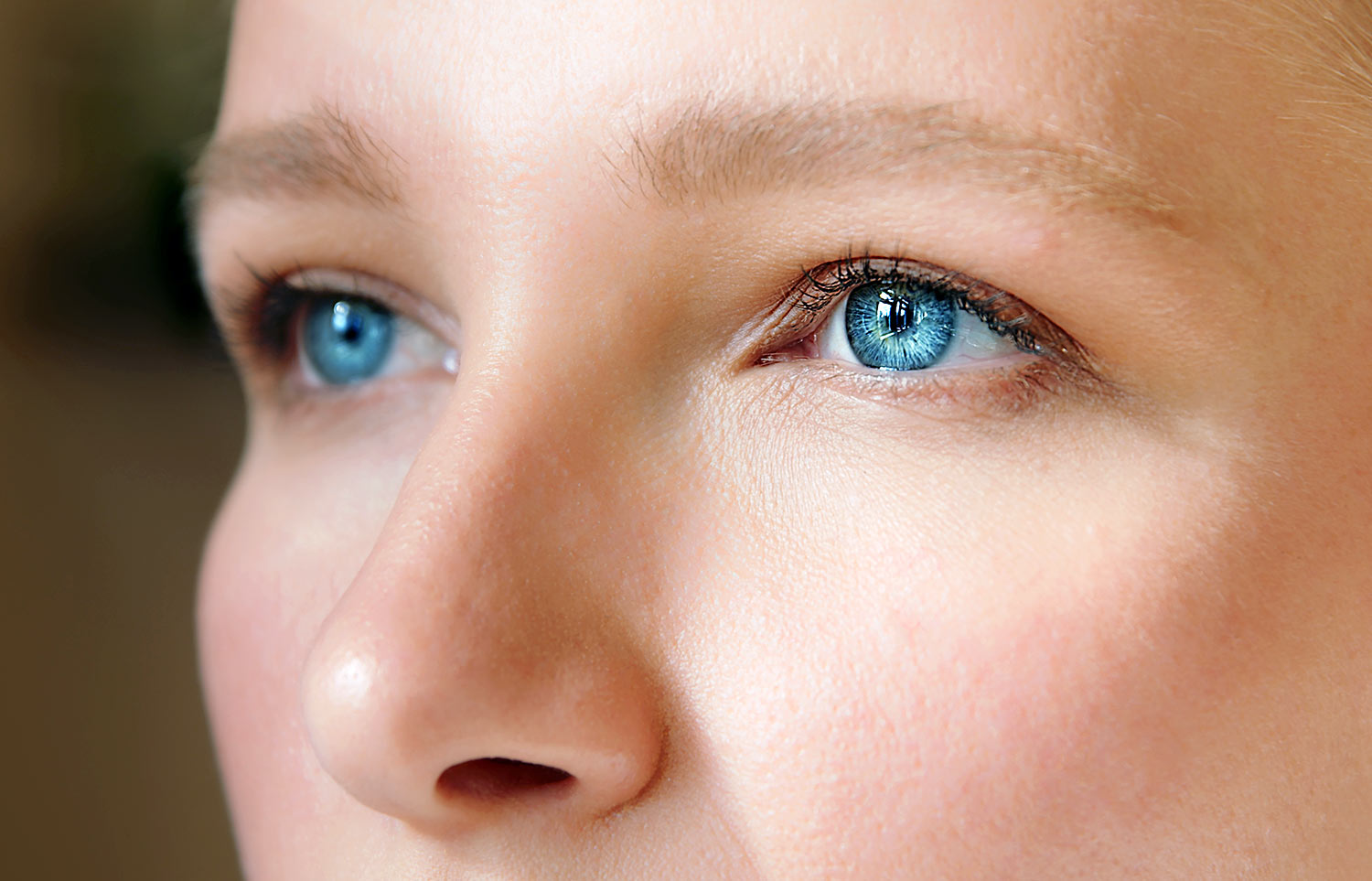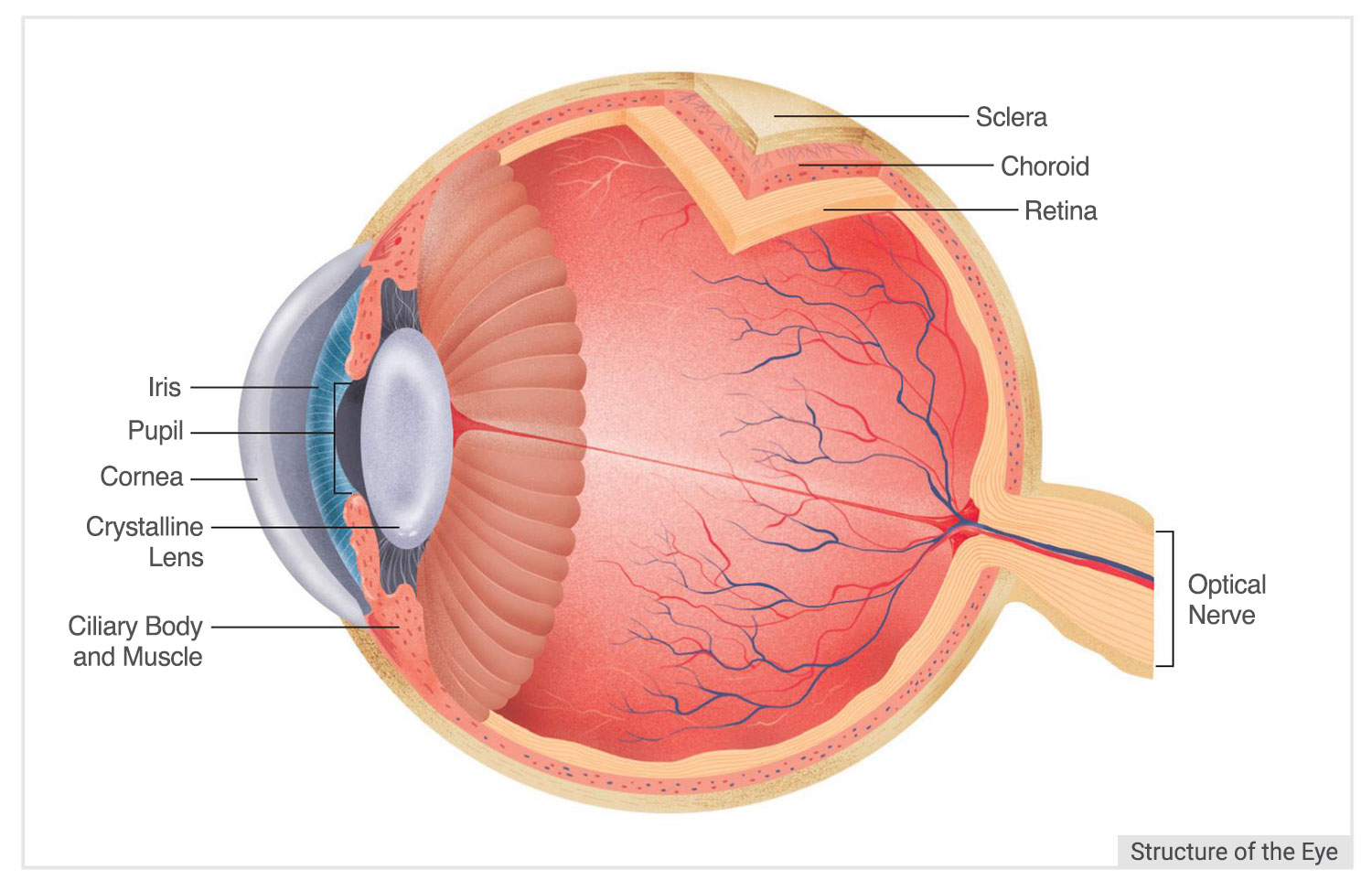The novel Blindness written by José Saramago, a Nobel Prize in Literature laureate, begins as a man suddenly goes blind while driving one ordinary afternoon. Soon after, his wife who nursed him, the patients of the clinic where the man came to receive treatment, and the eye doctor who treated him go blind. The unexplained blindness spreads like an epidemic, and society collapses rapidly. It is a novel that realistically depicts the power of vision just like the saying, “In the land of the blind, the one eyed-man is king.”
We often forget the importance of vision. However, it doesn’t take much to understand how much we depend on sight—you just need to cover your eyes. Humans receive so much information through vision that they rely on their eyes for nearly 80% of their sensory experiences. Let’s take a look at the complex and sophisticated sensory organ, the eye that connects us and the world.
Eye, a special and delicate sensory organ
A human eye which weighs around 7 grams [0.25 oz] and the size of a ping pong ball with a diameter of 2.4 centimeters [0.94 inch] can be described as a very complex biological camera with rich features such as focus and contrast adjustment, image stabilization, and image processing. The eye adds or subtracts the light that has entered through the cornea by adjusting the size of the iris. The light rays that enter the eye, are bent while passing the crystalline lens, and come to a focusing point on the retina. The image formed like this is carried by the optic nerve to the brain, and the brain analyzes this signal so that we can see the object.

It is not just one or two things that need to be taken care of during the process of making an image on the retina. To see something, you first need to move your eyes for them to hit the object precisely. The human eye has six freely movable muscles which enable us to look up, or look down, or look sideways, or even roll the eyes all four directions. For example, even while you are reading this sentence, your eye muscles are busy loosing and shrinking, moving the eyeball left and right.
The eyes can keep focusing steadily even when your body or head is moving. This is because the focus is constantly fine-tuned, taking into account the shaking of the body like the camera’s image stabilization. When the semicircular canals sense the direction of the movement and send a signal to the brain, the brain moves the eye in the opposite direction of the body’s movement. That’s how you can read a book in a shaking car.
After the eye is focused, the size of the pupil is adjusted so that an adequate amount of light can enter the eye which is like a dark room. The iris which is shaped like a doughnut functions like the aperture of a camera. When the light is weak, the eye opens the iris to enlarge the pupil, and when the light is strong, the eye closes the iris to make the pupil small so that only a certain amount of light can enter the eye. This rapid response, controlled by elaborate nerves, is called the pupillary light reflex, which can also be used to test brain function for abnormalities.
Even if you are looking at something close and suddenly look at a distant place, your eyes are focused instantly. The camera shifts the lens back and forth to focus, but the eye adjusts the focus by changing the thickness of the crystalline lens. When you see something close, the tissues attached to the crystalline lens loosen, resulting in thickening of the crystalline lens, and when you see far, those tissues pull the crystalline lens, making them thin; thus, they adjust the refractive index of the light. The reason we can see far and near alternatively in an instant is that the flexible crystalline lens adjusts its thickness instantly without losing its original shape.
One world seen with two eyes
Every vertebrate has two eyes. Why is it that it has two eyes, not just one? With one eye closed, hold a pencil in each hand, open your arms, and try to have the tips of the two pencils touch each other by closing your arms back. You’ll know right away why you need two eyes.
If you see the same object, alternating the eyes, you will see that the two images are slightly different from each other. The left and right eyes are about 60 to 70 millimeters [2.4 to 2.5 inch] apart, forming images by looking at the subject from different angles. This is called binocular disparity. The two eyes actually add a three-dimensional effect to our vision which actually sees the two dimensions, allowing us to feel 3D. The brain combines the visual information from each eye into one image and recognizes it. That is why three-dimensional effect is added to the vision while two different pieces of visual information become one. For those who see with only one eye, the world is probably like a series of pictures surrounding all around them.
From the movie Avatar, which is famous as a three-dimensional stereoscopic film, two cameras were used simultaneously. The basic principle of 3D stereoscopic images is to show images, which are taken from different angles by two cameras, to the left and right eyes by applying binocular disparity.

We see with our eyes? We see with our brain!
Both embryologically and anatomically, the eye is part of the brain. This is because the retina and optic nerve originate from the forebrain area in the early fetal development and the eye is directly connected to the brain through the optic nerve. Since the visual center is located in the rear part of the brain, an injury on the back of the head can cause loss of vision even if there is nothing wrong with the eyes.
The retina, which is also likened to a camera film, is a highly sensitive, high-quality nerve tissue. Visual cells in the retina convert the information coming in the form of light into electrical signals and send them to the brain. A rod cell, which is one of the visual cells, is so sensitive to light that it can respond to even a single photon of light, and it plays a main role in distinguishing light and shade in dark places. We can see the world even in the middle of the dark night, though dimly, because some 120 million rod cells do their jobs to the full. There are 6 million cone cells in a retina. Cone cells have three different types, each responding to red, green, and blue. The brain integrates and analyzes the nerve signals sent by cone cells, and distinguishes over one million colors. We are able to see a clear, colorful world in high definition thanks to these cone cells.
The visual information, which is converted into electrical signals in the retina, is transmitted through the optic nerve to the visual cortex of the brain located in the back of the head. The visual cortex, which is composed of about 30 areas, divides the basic images such as lines, borders, and corners, detects shapes, colors, or movements, and perceives faces; as various areas cooperate together, it grasps the overall image of an object.
If the part responsible for color does not function properly, even people who weren’t colorblind will see the world in black and white. If the part that sees continuous movement is damaged, even if you see a running car, you will see some choppy images as if you are watching a jerky clay animation. And if something with facial recognition area goes wrong, you will suffer from face blindness just like the case mentioned in the neurologist Oliver Sacks’ book, The Man Who Mistook His Wife for a Hat, where the man couldn’t even recognize his wife’s face.
An image search program’s cute mistakes—failing to distinguish between a chihuahua and a blueberry muffin, and between a cat and caramel ice cream—went viral online. While even three-year-olds can easily tell if it is a dog or a cat, it is not as simple as we think that artificial intelligence distinguishes different images. Image analysis by artificial intelligence technology is also developing by imitating the human visual information processing, but the completion stage is still a long way off.

In recent years, cameras that are beyond high-sensitivity and high-resolution cameras have been developed; they recognize faces and focus on people or automatically shoot in response to facial expressions. Even technology to recognize eye blink and avoid it is being implemented rapidly. State-of-the-art imaging technologies, such as virtual reality and 3D TV, are also developing to mimic the stereoscopic cognitive abilities and natural color perception of the human visual system. These technologies are already used in our eyes sophisticatedly. It is just that this fact has been discovered only recently.
The complex sequence that forms the precision of the eye structure and vision is incredible. Vision is a sophisticated and tricky sense that is formed only when all the links from the cornea to the visual cortex are engaged and function together in an instant. We’ve been seeing the world through our eyes for a long time. However, we didn’t realize how special our vision is. Various cameras and the incredible development of imaging technologies make us think anew about human body’s sense of seeing.
Does he who implanted the ear not hear? Does he who formed the eye not see? Ps 94:9
“The eye is the lamp of the body. If your eyes are good, your whole body will be full of light. But if your eyes are bad, your whole body will be full of darkness. If then the light within you is darkness, how great is that darkness!” Mt 6:22–23
- Reference
- Translated from Japanese into Korean by Kang Keum-hui and Lee Se-yeong, Senses: Amazing Mechanism, Newton Press Japan, 2015
- Translated from Japanese into Korean by Kang Keum-hui and Lee Se-yeong, Human Body: 21st Century Anatomy, Newton Press Japan, 2006
- Lee Eun-hui, Harihara’s Eye Story, Hankyoreh Press, 2016
- Tatsuo Sakai, Translated from Japanese into Korean by Yun Hye-rim, Anatomy, the Secret Hidden in My Body, Jeonnamusup, 2019